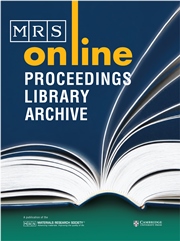Article contents
Novel Inorganic Hydrogels Based on The Polymerization ofCyanometalate Transition Metal Complexes With [PdCl4]2-: A New Approach To Ceramic And AlloyPrecursors
Published online by Cambridge University Press: 21 February 2011
Abstract
The reaction of a wide variety of cyanometalate complexes of the generalform [M(CN)x]n- (where M= a transition metal ion) withsquare planar [PdCl4]2- in aqueous solution leads tothe formation of linear polymers. Polymerization occurs via substitution ofchloride ligands on the Pd(II) centers, by the nitrogen end of the cyanideligand to generate extended bridging cyanide structures. Upon generation atroom temperature polymer solutions of this type under go a sol-geltransition to generate robust hydrogels having water content in excess of95%. In the case of the cyanocobaltate/tetrachloropalladate gel, pyrolysisat 900°C produces ferromagnetic Pd/Co metallic alloys having novelmorphological character. Materials formed with a hydrogel having a 2:1 Pd toCo stoichiometry are found to be “sponge-like”. When placed in water, themetallic matrix swells becoming pliable and holding up to seven equivalentsof water per metal site. The conductivity and magnetic properties of thismaterial are maintained in the swollen state. Sintering of the Pd/Cohydrogel in air generates the layered oxide, PbCoO2 having adelafossite structure.
Information
- Type
- Research Article
- Information
- Copyright
- Copyright © Materials Research Society 1998
References
REFERENCES
- 1
- Cited by

